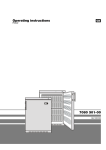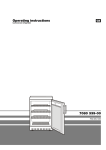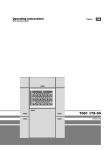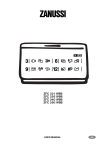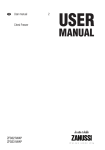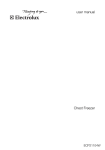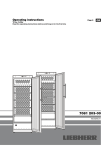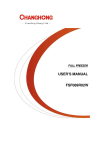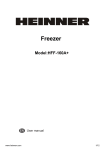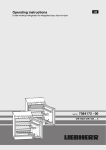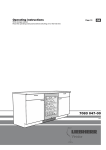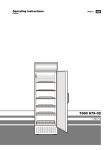Download Operating instructions 7080 301-00
Transcript
Operating instructions Freezer GB 7080 301-00 GG 1550 1205 Disposal notes Dimensions (mm) The packaging is made of recyclable materials. - Corrugated board/board - EPS moulded parts - Polythene sheets - Polypropylene straps Height: 850 mm • Keep packaging materials away from children - polythene sheets and bags can suffocate! • Please return the packaging material to an official collection point. Your old appliance: This contains some reusable materials and should be disposed of properly - not simply with unsorted household refuse. • Disable discarded appliances by removing the plug and cutting through the connection cable. Render the catch unusable so that children cannot become trapped inside. • Make sure that the refrigerant circuit of an appliance that is no longer needed is not damaged before it is collected or handed in at a municipal collection point. • Details of the refrigerant used can be found on the type plate. • Information on collection dates or collection points can be obtained from the waste disposal authorities or local council. Safety instructions and warnings • To prevent injury or damage to the unit, the appliance should be unpacked and set up by two people. • In the event that the appliance is damaged on delivery, contact the supplier immediately before connecting to the mains. • To guarantee safe operation, ensure that the appliance is set up and connected as described in these operating instructions. • Disconnect the appliance from the mains if any fault occurs. Pull out the plug, switch off or remove the fuse. • When disconnecting the appliance, pull on the plug, not on the cable. • Any repairs and work on the appliance should only be carried out by the customer service department, as unauthorised work could prove highly dangerous for the user. The same applies to changing the mains power cable. • Do not allow naked flames or ignition sources to enter the appliance. When transporting and cleaning the appliance ensure that the refrigerant circuit is not damaged. In the event of damage, make sure that there are no ignition sources nearby and keep the room well ventilated. • Do not stand on the plinth, drawers or doors or use them to support anything else. • This appliance is not intended for use by persons (including children) with reduced physical, sensory or mental capabilities or lack of experience and knowledge unless they have been given initial supervision or instruction concerning use of the appliance by a person responsible for their safety. Children should be supervised to ensure that they do not play with the appliance. • Avoid prolonged skin contact with cold surfaces or chilled/frozen food. This could cause pain, numbness and frostbite. In the case of prolonged skin contact, protective measures should be taken, e.g. gloves should be worn. • Do not eat ice cream, particulary ice lollies or ice cubes, immediately after taking them from the freezer compartment as there is a risk of "burning" because of the very cold temperatures. • Do not consume food which has been stored for too long, as it could cause food poisoning. • Do not store explosives or sprays using combustible propellants such as butane, propane, pentane etc. in the appliance. Electrical components might cause leaking gas to ignite. You may identify such sprays by the printed contents or a flame symbol. • Do not use electrical appliances inside the appliance. Width: 600 mm Setting up • Avoid positioning the appliance in direct sunlight or near cookers, radiators and similar sources of heat. • The floor on which the appliance stands should be horizontal and level. To compensate for any unevenness, adjust the height of the feet with the open-ended wrench supplied. • The ventilation grilles should not be obstructed. Always ensure that there is good ventilation and that the outward flowing air is able to escape. • Do not place heat-emitting appliances, e.g. microwave oven, toaster, etc., on top of the freezer. • Standard EN 378 specifies that the room in which you install your appliance must have a volume of 1 m3 per 8 g of R 600a refrigerant used in the appliance, so as to avoid the formation of inflammable gas/air mixtures in the room where the appliance is located in the event of a leak in the refrigerant circuit. The quantity of refrigerant used in your appliance is indicated on the type plate on the inside of the appliance. The appliance is set to operate within specific ambient temperature limits according to its climate rating. These temperature limits should not be exceeded. The correct climate rating for your appliance is indicated on the type plate. Climate rating SN, N ST T Ambient temperatures up to +32 °C up to +38 °C up to +43 °C Connecting to the mains Power supply (a.c.) and voltage at the operating point must comply with the details on the type plate which is located on the left-hand inside wall, next to the top freezer drawer. The socket must be fused with a 10 A fuse or higher. The socket should be easily accessible and not directly behind the appliance. Connect the appliance with a properly earthed fused plug and socket only. Switching the appliance on and off You are recommended to clean the appliance before switching it on for the first time (see Cleaning). Switch the appliance on 4 hours before loading it with frozen food for the first time. The appliance is delivered ready for use and wired for normal operation (approx. -18°C). When it is connected up the appliance is ready for operation. The green ON lamp ➋ comes on. To switch the appliance off: Turn the arrow on the temperature control ➊ to 0 and. Setting the temperature Using a coin, turn the arrow on the temperature control ➊ to a setting between 1 und SF. Setting 1 = lowest cooling setting, warm Setting SF = highest cooling setting, cold For long-term storage of frozen food a temperature of at least -18°C is recommended. Temperature display The thermometer shows the warmest frozen food temperature. It is adjusted and designed so that only temperatures below 0°C are accurately displayed. 4 Depth: 605 mm GB Freezing Malfunctions Fresh food should be frozen to the core as rapidly as possible. The maximum amount of food wich can be frozen in 24 hours is shown on the type plate (Freezing capacity ...kg/24 hours). You may be able to rectify the following faults by checking the possible causes yourself: • Approx. 24 hours before placing food in freezer: Set the temperature control to SF. • Place the fresh food in the freezer. • After approx. 24 hours the fresh food will be frozen. You can freeze smaller quantities of up to 1 kg of food daily without changing the temperature setting. Defrosting After a longer period of operation a layer of frost or ice can build up on the cooling plates in the freezer compartment. This will increase the energy consumption of the freezer. The cooling plates should therefor be defrosted regularly. • Switch the appliance off to defrost. Pull out the mains plug or set the temperature control to 0. • Wrap the frozen food in paper or blankets and store in a cool place. • Pull out the defrost drain pipe and place a bowl underneath. • To speed up the defrosting process put a saucepan of hot but not boiling water on one of the cooling elements. • Leave the door of the appliance open while defrosting. After defrosting mop up the remaining water and clean the appliance. Do not use any mechanical devices or other artificial aids for defrosting other than those recommended by the manufacturer. Cleaning Before cleaning always switch off the appliance. Pull out the mains plug or remove/unscrew the fuse. Appliance does not function: the control lamps are not lit. – Is the appliance switched on? – Is the plug correctly fitted in the mains socket? – Is the socket fuse intact? The temperature is not low enough: – Is the temperature setting correct (see Setting the temperature)? – Have excessive amounts of fresh food been placed in the appliance? Observe the temperature display for a further 24 hours. – Does the separately installed thermometer show the correct reading? – Is the ventilation system working properly? – Is the appliance set up too close to a heat source? If none of the above causes apply and you cannot rectify the fault yourself, contact the nearest customer service department stating the type of appliance ➊, index ➋ and appliance number ➌ as indicated on the type plate. The type plate is located in the freezer compartment on the left-hand inside wall, next to the top freezer drawer. Changing over door hinges • Close the door and unscrew the hinge bracket ➊. • Pull the door out at the bottom and lift off. • Unscrew the hinge pin ➋ from the hinge bracket ➊ and screw into the adjacent retaining hole. • Lift off the cover plate ➌ and seal the retaining holes on the other side with it. • Unscrew hinge pin ➍ and screw in on opposite side. • Attach door handle ➎ and plastic plugs ➏. • Insert plug ➐ in the exposed door mounting. • Mount door on hinge pin ➍ and close. • Insert hinge bracket ➊ in lower door mounting and screw onto plinth. Clean the inside, equipment parts and outer walls with lukewarm water and a little detergent. Do not use abrasive or acid cleaners or chemical solvents. Do not use steam cleaners because of the risk of injury and damage. • Ensure that no cleaning water penetrates into the electrical components or ventilation grille. • Dry all parts well with a cloth. • The dust should be removed from the refrigeration unit and heat exchanger – metal grid at the back of the appliance – once a year. • Do not damage or remove the type plate on the inside of the appliance. It is very important for servicing purposes. Shutting your appliance down If your appliance is to be shut down for any length of time, switch it off and disconnect the plug or remove the fuse. Clean the appliance and leave the door open in order to prevent unpleasant smells. The refrigerant circuit has been tested for leaks. The appliance is radio-suppressed to EN 55014 and thus complies with EC Directive 87/308/EEC. 5



